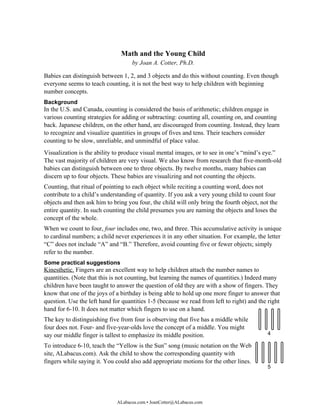
Math and the Young Child
- 1. Math and the Young Child by Joan A. Cotter, Ph.D. Babies can distinguish between 1, 2, and 3 objects and do this without counting. Even though everyone seems to teach counting, it is not the best way to help children with beginning number concepts. Background In the U.S. and Canada, counting is considered the basis of arithmetic; children engage in various counting strategies for adding or subtracting: counting all, counting on, and counting back. Japanese children, on the other hand, are discouraged from counting. Instead, they learn to recognize and visualize quantities in groups of fives and tens. Their teachers consider counting to be slow, unreliable, and unmindful of place value. Visualization is the ability to produce visual mental images, or to see in one’s “mind’s eye.” The vast majority of children are very visual. We also know from research that five-month-old babies can distinguish between one to three objects. By twelve months, many babies can discern up to four objects. These babies are visualizing and not counting the objects. Counting, that ritual of pointing to each object while reciting a counting word, does not contribute to a child’s understanding of quantity. If you ask a very young child to count four objects and then ask him to bring you four, the child will only bring the fourth object, not the entire quantity. In such counting the child presumes you are naming the objects and loses the concept of the whole. When we count to four, four includes one, two, and three. This accumulative activity is unique to cardinal numbers; a child never experiences it in any other situation. For example, the letter “C” does not include “A” and “B.” Therefore, avoid counting five or fewer objects; simply refer to the number. Some practical suggestions Kinesthetic. Fingers are an excellent way to help children attach the number names to quantities. (Note that this is not counting, but learning the names of quantities.) Indeed many children have been taught to answer the question of old they are with a show of fingers. They know that one of the joys of a birthday is being able to hold up one more finger to answer that question. Use the left hand for quantities 1-5 (because we read from left to right) and the right hand for 6-10. It does not matter which fingers to use on a hand. The key to distinguishing five from four is observing that five has a middle while four does not. Four- and five-year-olds love the concept of a middle. You might say our middle finger is tallest to emphasize its middle position. 4 To introduce 6-10, teach the “Yellow is the Sun” song (music notation on the Web site, ALabacus.com). Ask the child to show the corresponding quantity with fingers while saying it. You could also add appropriate motions for the other lines. 5 ALabacus.com • JoanCotter@ALabacus.com
- 2. Yellow is the Sun Yellow is the sun. 4 Six is five and one. Why is the sky so blue? 8 Seven is five and two. Salty is the sea. 6 Eight is five and three. 9 Hear the thunder roar. Nine is five and four. 7 Ducks will swim and dive. 10 Ten is five and five. –J. A. Cotter Visual. Just as our fingers naturally group in fives, our brains require grouping in fives to recognize and visualize quantities. To understand the importance of grouping, try to mentally see 8 apples in a line without any grouping–virtually impossible. Next try to see 5 of those apples as red and 3 as green. Now you probably can imagine them. Thousands of years ago, the Romans grouped their numerals in fives: VIII is 8. Piano music needs 10 lines, but composers arranged them into two groups of five. After the child has mastered the names of the quantities 1-10, use tally sticks (craft sticks) for representing quantities. Show the child how to lay out 3 sticks, about an inch (2.5 cm) apart, as shown. When the child can both lay out 4 and identify 4, present 5 with the fifth stick laid horizontal- 3 5 ly across the remaining four sticks as shown. Continue through to 10. If you go past 10, start a new row. Give the child simple problems to solve with these sticks, “What is 4 apples and 3 more apples?” With the 7 sticks laid out, ask, “How can you tell how much this is without counting?” The solution is to take one stick from the 3 and give it to the 4, making 5 and 2, which we know is 7. 4 and 3 Incidentally, Japanese children are taught to remember 4 + 3 by visualizing the 4 and the 3 and mentally transforming them into 5 and 2. Auditory. For numbers greater than 10, we need to group in tens. The English language, especially the teens, does not make clear the tens 7 structure of our number system. For example, fourteen does not give the child an inkling that it is really “ten and four.” English, as well as other Indo-European languages, is inconsistent in naming numbers 11-99. Centuries ago, the Chinese changed their language to make the “name” of a number match its “value.” So 11, 12, 13 are named ten-1, ten-2, ten-3, 20 is 2-ten, 21 is 2 ten-1, and so forth to 99, 9-ten 9. Other Asian languages also use value naming. Research shows this greatly helps children understand place value. Therefore, teach your young child to count to 100 using this “math” way of counting. Later on, teach the traditional names. In summary, we need to help young children build on the visualization skills they exhibit as infants and avoid rote counting. We must group in fives and use the math way of counting. ALabacus.com • JoanCotter@ALabacus.com rev Aug 2005